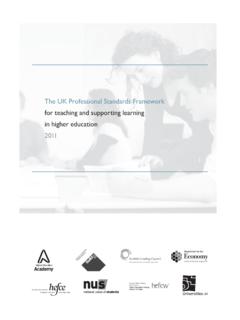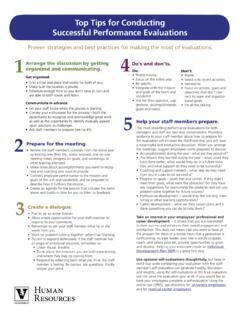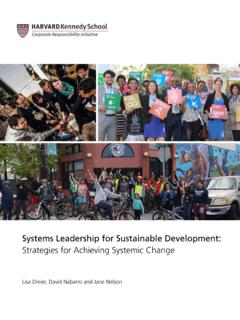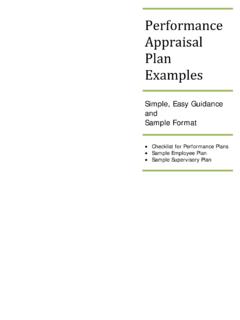Transcription of Aligning teaching for constructing learning
1 Aligning teaching for constructing learning John Biggs Summary ' constructive alignment ' starts with the notion that the learner constructs his or her own learning through relevant learning activities. The teacher's job is to create a learning environment that supports the learning activities appropriate to achieving the desired learning outcomes. The key is that all components in the teaching system - the curriculum and its intended outcomes, the teaching methods used, the assessment tasks - are aligned to each other. All are tuned to learning activities addressed in the desired learning outcomes. The learner finds it difficult to escape without learning appropriately.
2 Biography John Biggs obtained his from the University of London in 1963, and has held Chairs in Education in Canada, Australia, and Hong Kong. He retired in 1995 to act as a consultant in Higher Education, and has been employed in this capacity in many institutions in Australia, Hong Kong, and the United Kingdom. Keywords intended learning outcomes, constructive alignment , criterion-referenced assessment, teaching for active learning , systems approach to teaching Introduction teaching and learning take place in a whole system, which embraces classroom, departmental and institutional levels. A poor system is one in which the components are not integrated, and are not tuned to support high-level learning .
3 In such a system, only the 'academic' students use higher-order learning processes. In a good system, all aspects of teaching and assessment are tuned to support high level learning , so that all students are encouraged to use higher-order learning processes. ' constructive alignment ' (CA) is such a system. It is an approach to curriculum design that optimises the conditions for quality learning . For an example of a poor system, here is what a psychology undergraduate said about his teaching : 'I hate to say it, but what you have got to do is to have a list of 'facts'; you write down ten important points and memorize those, then you'll do all right in the test.
4 If you can give a bit of factual information - so and so did that, and concluded that - for two sides of writing, then you'll get a good mark.' Quoted in Ramsden (1984: 144) The problem here was not the student. In fact, this student liked writing extended essays, and finally graduated with First Class Honours, but he was contemptuous of these quick and snappy assessments. So in psychology, he made a strategic decision to memorise, knowing that it was enough to get him through, saving his big guns for his major subject. The problem here was the assessment: it was not aligned with the aims of teaching . So often the rhetoric in courses and programmes is all that it should be, stating for example that students will graduate with a deep understanding of the discipline and the ability to solve problems creatively.
5 Then they are told about creative problem solving in packed lecture halls and tested with multiple-choice tests. It's all out of kilter, but such a situation is not, I strongly suspect, all that uncommon. What is constructive alignment ? ' constructive alignment ' has two aspects. The ' constructive ' aspect refers to the idea that students construct meaning through relevant learning activities. That is, meaning is not something imparted or transmitted from teacher to learner, but is something learners have to create for themselves. teaching is simply a catalyst for learning : 'If students are to learn desired outcomes in a reasonably effective manner, then the teacher's fundamental task is to get students to engage in learning activities that are likely to result in their achieving those It is helpful to remember that what the student does is actually more important in determining what is learned than what the teacher does.
6 ' (Shuell, 1986: 429) The ' alignment ' aspect refers to what the teacher does, which is to set up a learning environment that supports the learning activities appropriate to achieving the desired learning outcomes. The key is that the components in the teaching system, especially the teaching methods used and the assessment tasks, are aligned with the learning activities assumed in the intended outcomes. The learner is in a sense 'trapped', and finds it difficult to escape without learning what he or she is intended to learn. In setting up an aligned system, we specify the desired outcomes of our teaching in terms not only of topic content, but in the level of understanding we want students to achieve.
7 We then set up an environment that maximises the likelihood that students will engage in the activities designed to achieve the intended outcomes. Finally, we choose assessment tasks that will tell us how well individual students have attained these outcomes, in terms of graded levels of acceptability. These levels are the grades we award. There are thus four major steps: 1. Defining the intended learning outcomes (ILOs); 2. Choosing teaching / learning activities likely to lead to the ILOs; 3. Assessing students' actual learning outcomes to see how well they match what was intended; 4. Arriving at a final grade. Defining the ILOs When we teach we should have a clear idea of what we want our students to learn.
8 More specifically, on a topic by topic basis, we should be able to stipulate how well each topic needs to be understood. First, we need to distinguish between declarative knowledge and functioning knowledge. Declarative knowledge is knowledge that can be 'declared': we tell people about it, orally or in writing. Declarative knowledge is usually second-hand knowledge; it is about what has been discovered. Knowledge of academic disciplines is declarative, and our students need to understand it selectively. Declarative knowledge is, however, only the first part of the story. We don't acquire knowledge only so that we can tell other people about it; more specifically, so that our students can tell us - in their own words of course - what we have recently been telling them.
9 Our students need to put that knowledge to work, to make it function. Understanding makes you see the world differently, and behave differently towards that part of the world. We want lawyers to make good legal decisions, doctors to make accurate diagnoses, physicists to think and behave like physicists. After graduation, all our students, whatever their degree programmes, should see a section of their world differently, and to behave differently towards it, expertly and wisely. Thus, simply telling our students about that part of the world, and getting them to read about it, is not likely to achieve our ILOs with the majority of students. Good students will turn declarative into functioning knowledge in time, but most will not if they are not required to.
10 Accordingly, we have to state our objectives in terms that require students to demonstrate their understanding, not just simply tell us about it in invigilated exams. The first step in designing the curriculum objectives, then, is to make clear what levels of understanding we want from our students in what topics, and what performances of understanding would give us this knowledge. It is helpful to think in terms of appropriate verbs. Generic high level verbs include: Reflect, hypothesise, solve unseen complex problems, generate new alternatives Low level verbs include: Describe, identify, memorise, and so on. Each discipline and topic will of course have its own appropriate verbs that reflect different levels of understanding, the topic content being the objects the verbs take.











